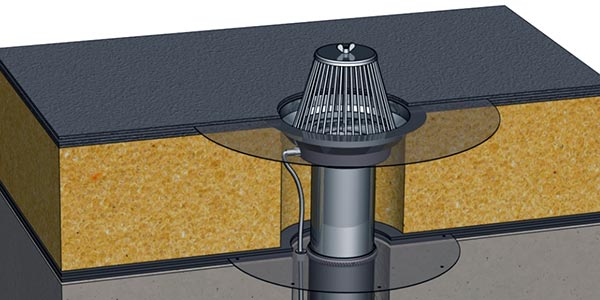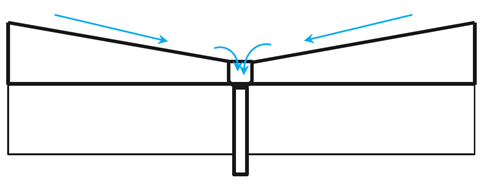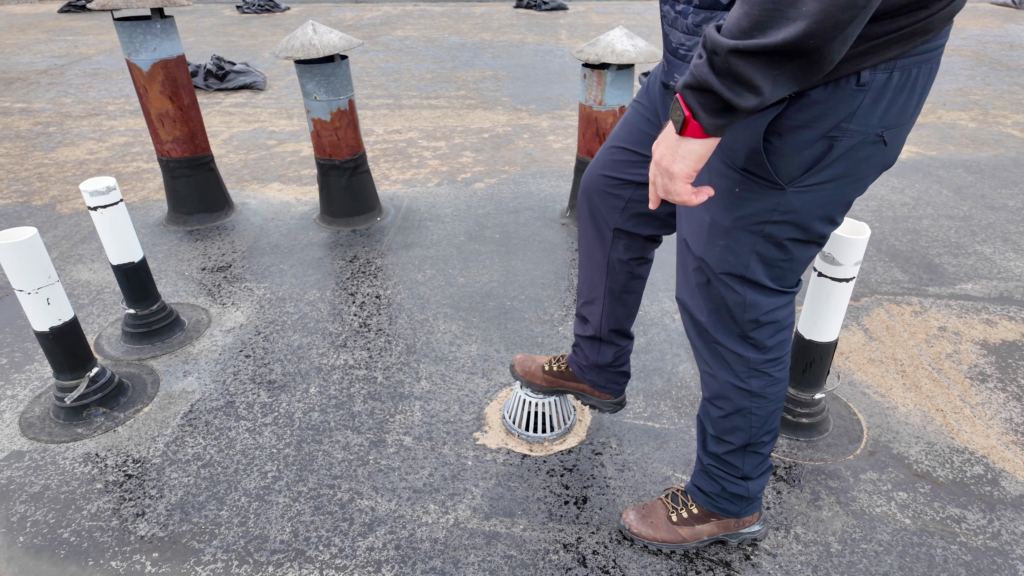Flat roof drain: why it is vital to keep your roof dry and clean
Reading Time: 4 minutesYour city has hundreds of buildings with flat roofs and flat roof drain systems. Such roof structures are common in malls, industrial enterprises, warehouses, and office centers. More and more private real estate owners choose just such a roof with a flat roof drain for their homes every year.

Flat roofs have some weaknesses despite the many vital advantages and modern appearance. Like standing water, water pooling, or leaks, especially if the roof drainage system does not work correctly.
Preventing Leaks and Water Damage with a Properly Installed Flat Roof Drain System
Roof leaks and water damage are one of the most dangerous problems for your property. Even a tiny amount of water that seeps through the roofing can seriously damage the roof frame and underlayment, the building walls and structure, and your property inside the rooms.
As said above, architectural features make flat roofs more prone to leaks. If the drainage system and drains are clogged or installed incorrectly, the chances of leaks increase.
Therefore, ensuring that the roof surface remains dry and clean and the drainage system works perfectly is essential.
What is Flat Roof Scrupper?
Flat Roof Scupper Drainage: All You Need to Know About Scuppers
How to understand that the roof drainage system is not working
The main alarming symptom is that standing water and puddles collect on the roof’s surface. When the drainage system does not work correctly, water tends to gather near the drains and the lowest areas of the roof. With more severe problems, water contains on the entire roof area or in the center of a top.
Even if there is not much water, it can cause severe damage to the covering material and cause the appearance of mold, fungus, rot, and other troubles to your property.
While modern flat roofing materials are relatively waterproof and durable, they can’t withstand exposure to water for an extended period.
As experienced roofers note, the roof with proper drainage dries out after heavy rain within 48 hours maximum. If you notice puddles on the roof surface after 48 hours, the drainage system is most likely not working.
Don’t Miss Our Latest Articles on Professional Roofing Techniques
The main problems with the drainage system of the roof
- The first reason is improper installation of the roof. Any flat roof has a slight slope that allows water to flow in the right direction. If your roof has several levels, moisture can collect at the junction of different roof levels and the intersection of flat and sloping roof parts.
- The second reason is the improperly installed drainage system and gutters. Water should not drain from the roof’s edge but through the drainage system. If the drainage system installation is incorrect, water will drain in the wrong place or collect on the roof surface.
- A clogged drain is the third most common cause of drainage problems. Branches, leaves, dirt, and other debris can clog the drainage system.
- Damaged roofing or thermal insulation – is one more issue. Even small cracks and damage on the roof surface will collect standing water. Installing air conditioners and other heavy equipment on the roof surface and walking on the roof covering can also cause such problems.
- Finally, water can collect on large roof areas if the drainage system cannot manage such water. This problem is typical for commercial buildings and buildings with large roofing areas.

How to solve roof drainage problems
First, paying utmost attention to the drainage system’s design before the roof’s installation is necessary. Contact the experts who will design the drainage, taking into account the area of the top and the architectural features of the building.
The drainage includes drains, gutter systems, downpipes, and pits. There are several types of roof drainage systems. Each of them has its pros and cons.
- Scupper drains are one of the most common types of drainage for flat roofing systems with barrier perimeters like parapet walls. Drainage consists of channels and holes into which water flows.
- Guttering Systems. This drainage system is suitable for flat and pitched roofs and residential buildings with classic architectural features.
- Siphonic flat roof drain systems. This type of drainage is suitable for commercial buildings.
Secondly, periodically check the roof surface, especially after heavy rains and snow melt. If you notice standing water and puddles that do not disappear after 1-2 days, contact your roofers.
Thirdly, clean gutters and other elements of the drainage system. Even a small amount of debris can lead to severe leaks and costly roof repairs later.
Also, fix problems with low points on the roof surface. Flat roofs have weak points where water usually collects: at the junctions of ceilings of different types and different heights, near chimneys, skylights, and air conditioners.
Improve the drainage system if the old system cannot handle the amount of water and weather conditions. Roofers can check drainage and install additional downspouts or siphon systems to drain water faster and more efficiently.
Tips for repairing and installing a drainage system
- Sometimes, it isn’t the flat roof drainage system that causes problems with standing or ponding water, but structural damage to the roof, improper roof slope, and roof installation mistakes. To solve the problem, you will need to renovate the top first.
- Ensure the drainage system does not get debris that can clog the drains. Otherwise, the system cannot drain the flat roof in 48 hours.
- Install sufficient roof drains for a flat roof that will carry water to its intended place.
- Pay special attention to waterproofing the “weak spots” of flat roofs, depending on the type of drainage system and flat roof features.
- Don’t put off solving your drainage problems. Otherwise, standing water and leaks can be a source of costly repairs in the future.
- If you notice water collecting on the roof surface, contact a professional roofer who will inspect the roof and find the source of the flat roof drain problem as soon as possible.
Denis is the driving force behind ID Flat Roof, a leading company in Boston specializing in flat roof repair and installation for over 20 years.
Expertise:
Denis excels in PVC, TPO, EPDM, and rubber roofing. His meticulous approach ensures quality and customer satisfaction.
Innovation:
Denis incorporates cutting-edge solutions like skylights and solar PV roofing.





What can you do about the roof gravel draining into flat roof rain harvesting system drains or into rain gutters at roof edge? Rain water flow is moving the gravel.
Install Gravel Stops: Use gravel stops around the perimeter of the roof. These are metal or PVC profiles designed to keep gravel from sliding off the roof and into the gutters or drains.
Use Filter Fabric: Line rain gutters and drainage areas with filter fabric. This allows water to pass through while capturing gravel and larger debris, preventing them from clogging the system.
Regular Maintenance: Regularly inspect and clean the gutters and drainage points on your roof to remove any accumulated gravel or debris that could obstruct water flow.
Adjust Roof Slope: Ensure the roof has the correct slope towards drainage points to minimize the movement of gravel and enhance water flow directly into the drains.